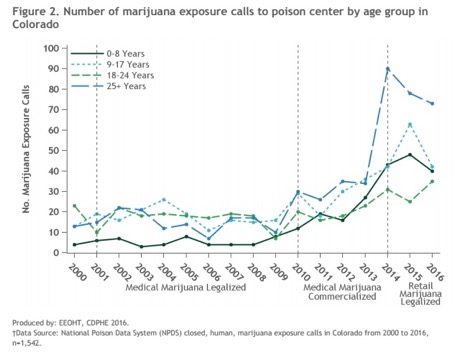
Dr. Larry Wolk is Governor Hickenlooper’s appointed Chief Medical Officer and Executive Director of the Colorado Department of Public Health and Environment (CDPHE). A Canadian talk show’s interview with Wolk was reported by Canada’s CBC News on October 23, 2017. If the report is true, Hickenlooper should immediately replace Wolk with someone more responsible. According to the report, Wolk advised Canadians asking about the impact of marijuana legalization in Colorado, “We haven’t experienced any significant issues as a result of legalization.”
Other reported comments from Wolk include:
- “Somewhat” regular use by adults and youth hasn’t changed since legalization.
- Although there have been a few more visits to the ER, most of those were visitors, not residents.
- The effects of marijuana combined with alcohol are not just additive, but exponential.
- Biologically, the legal age for using marijuana should be 25, but it may make sense to align the legal age with the legal drinking age (19 in Canada).
- There has been no increase in recorded impaired driving but the numbers are difficult to track.
- There is no clear evidence either way on whether or not marijuana is a gateway drug.
It’s not clear where Wolk’s head has been buried, but it hasn’t been in the publications of CDPHE, the Department of Revenue (DOR) or that of the Rocky Mountain High Intensity Drug Trafficking Area (HIDTA), all of which refute Wolk’s comments, or at least his message, which is that marijuana is benign – don’t worry, go ahead and legalize it.
Wolk’s comments are based largely upon the 2016 report of his own agency (Monitoring Health Concerns Related to Marijuana in Colorado) that emphasized discredited survey data from 2013 and 2015. The response rate was only 48% and five counties refused to participate. Differences between two successive years do not make a convincing trend and do not take into account significant upward trends in the 12-17 year-olds and 18-24 year olds in the National Survey on Drug Use and Health. The important distinction would be today compared with pre-commercialization, which occurred after 2009, when Obama decided to no longer enforce federal drug laws.
Wolk is clearly trying to convince us that legalization hasn’t increased use of marijuana. How, then does he explain tax revenue reported by the Department of Revenue (DOR)?
|
Calendar Year |
Total Revenue |
|
2014 |
$ 67,594,323 |
|
2015 |
$130,411,173 |
|
2016 |
$193,604,804 |
|
2017 (Jan-Sept) |
$181,981,627 |
Yes, I know, this is only taxable product and doesn’t include usage from the grey market and the black market that was supposedly erased by legalization, and DOR estimated that less than half of the pot consumed in the state in 2014 came from tax-paying licensed drug dealers. But that’s the best information we have today.
There are no public data to support Wolk’s statement that most increases in marijuana-caused emergency room incidents were due to visitors, rather than residents. DOR estimated that less than 7% of the state’s use of marijuana was by visitors. Wolk’s own agency reports:
- Marijuana exposure calls to the poison center continue to be higher in years after marijuana commercialization (2010-2016) than in previous years (2000-2009), including calls about children 0-8 years old with unintentional marijuana exposure.
- The overall rate of hospitalizations with marijuana-related billing codes has increased each year since 2008.
- The following graph is from his own agency’s 2016 report:

But according to Wolk, this is not a significant issue, at least not for residents!
Wolk was almost right about the effect of alcohol and marijuana combined, but he overstated the effect. Most research has found that the effects of alcohol and THC are additive or slightly synergistic, but by no means exponential. The latest, for example, from Guohua Li from Columbia University found after studying 14,742 fatal two-vehicle crashes, that someone on marijuana had a 62% higher risk of causing a fatal crash than someone who was sober. Someone on alcohol had a 432% higher risk, and someone on both had a 539% higher risk.
Yes, biologically, the human brain’s wiring becomes “fixed” in the mid 20s, after which it is less likely that someone would experience permanent brain damage or addiction from marijuana use. So picking age 25 is supportable. But “aligning the legal age for marijuana and alcohol use” is a political proposal, not one based in medicine or science.
Wolk’s deceptive claim about drug-impaired driving is the most shameful of all. The reason there is no increase in recorded drug-impaired driving is that Colorado doesn’t record any drug-impaired driving cases. The state chooses to have a single statute for DUI irrespective of cause and no statewide database separates DUI charges into alcohol, drugs or a combination of drugs.
That is why Colorado must rely on grossly inadequate surrogate measures for the effect of marijuana on impaired driving. Surrogate measures such as FARS data published by Rocky Mountain HIDTA showing marijuana-related traffic deaths increased 66 percent in the four-year average (2013-2016) since legalization compared to the immediate four years previous, while during the same time period, all traffic deaths increased 16 percent. In 2009, 9% of Colorado’s highway deaths involved drivers testing positive for marijuana. That more than doubled to 20% by 2016.
Although there are no state-wide data on marijuana-caused DUI arrests, some law enforcement agencies report partial data on their own. Marijuana-caused DUI arrests have increased since legalization in all agencies that have reported results.
Although Wolk’s carefully-worded impaired-driving statement prevents us from saying it is an outright lie, we can confidently say that his statement was deceptive.
District Attorney Dan May said in July that marijuana was a gateway drug to homicide. But presumably Wolk was talking about the question of marijuana’s role as a gateway to drugs like heroin. Although few marijuana users progress to heroin, there may be no heroin users who did not start their drug addiction with use of marijuana. Regardless of what drug these people are using, they still have a drug addiction that needs to be addressed. There are multiple health issues involved with drug addictions, some of which are listed below. To avoid them, it’s vital to acknowledge the addiction and seek help from professionals who can support you.
Wolk’s own agency admits that:
- Marijuana use by youths results in impaired learning, failure to graduate, psychotic episodes and addiction;
- Marijuana increases crash risk which is made even worse when combined with alcohol;
- Marijuana is associated with the development of schizophrenia;
- Marijuana may increase the incidence of workplace injuries;
- Marijuana use increases the risk of some forms of strokes;
- Marijuana use during pregnancy can lead to stillbirths, heart defects, and mental impairment;
- Marijuana can cause chronic bronchitis, bullous lung disease, and pneumothorax.
Why does Larry Wolk not consider these to be significant issues? Why are his marijuana statements so deceptive? Why does he sound like a spokesman for the marijuana lobby? Who does he really work for? Why doesn’t Governor Hickenlooper fire him?
